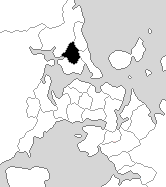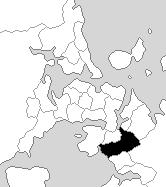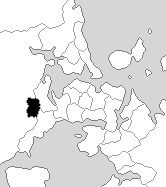
Birkenhead was a New Zealand Parliamentary electorate on Auckland's North Shore from 1969 to 1996, when it was absorbed into the Northcote electorate.

Birkenhead was a New Zealand Parliamentary electorate on Auckland's North Shore from 1969 to 1996, when it was absorbed into the Northcote electorate.
Through an amendment in the Electoral Act in 1965, the number of electorates in the South Island was fixed at 25, an increase of one since the 1962 electoral redistribution. [1] It was accepted that through the more rapid population growth in the North Island, the number of its electorates would continue to increase, and to keep proportionality, three new electorates were allowed for in the 1967 electoral redistribution for the next election. [2] In the North Island, five electorates were newly created (including Birkenhead) and one electorate was reconstituted while three electorates were abolished. [3] In the South Island, three electorates were newly created and one electorate was reconstituted while three electorates were abolished. [4] The overall effect of the required changes was highly disruptive to existing electorates, with all but three electorates having their boundaries altered. [5] These changes came into effect with the 1969 election. [2]
This suburban electorate was on the North Shore of Auckland. Most of its original area had previously been with the Waitemata electorate. [6] It was absorbed into the Northcote electorate.
Norman King of the Labour Party had first been elected to the Waitemata electorate in the 1954 election. He was the first representatives for the Birkenhead electorate when it was created for the 1969 election. [7] King was defeated in the 1975 election by Jim McLay of the National Party. [8]
The electorate was abolished in the 1996 election, the first mixed-member proportional (MMP) election.
Key
| Election | Winner | |
|---|---|---|
| 1969 election | Norman King | |
| 1972 election | ||
| 1975 election | Jim McLay | |
| 1978 election | ||
| 1981 election | ||
| 1984 election | ||
| 1987 election | Jenny Kirk | |
| 1990 election | Ian Revell | |
| 1993 election | ||
| (Electorate abolished in 1996; see Northcote) | ||
| Party | Candidate | Votes | % | ±% | |
|---|---|---|---|---|---|
| National | Ian Revell | 7,866 | 36.99 | -12.16 | |
| Labour | Ann Hartley | 7,762 | 36.50 | ||
| Alliance | Bob Lack | 3,314 | 15.58 | ||
| NZ First | Ruth Norman | 1,681 | 7.90 | ||
| Christian Heritage | Tony Brebner | 364 | 1.71 | ||
| McGillicuddy Serious | Ben Nicholson | 164 | 0.77 | ||
| Natural Law | Angela Wood | 68 | 0.31 | ||
| Workers Rights | Caroline Selwood-Hatt | 45 | 0.21 | ||
| Majority | 104 | 0.48 | -13.21 | ||
| Turnout | 21,264 | 85.98 | -0.54 | ||
| Registered electors | 24,730 | ||||
| Party | Candidate | Votes | % | ±% | |
|---|---|---|---|---|---|
| National | Ian Revell | 10,094 | 49.15 | ||
| Labour | Jenny Kirk | 7,281 | 35.45 | -18.25 | |
| Green | Michael Crowther | 1,820 | 8.86 | ||
| NewLabour | Ross Tozer | 900 | 4.38 | ||
| Democrats | Richard George Midson | 179 | 0.87 | -1.05 | |
| McGillicuddy Serious | Katerina Jane Julian | 161 | 0.78 | ||
| Independent | Tony Seagar | 99 | 0.48 | ||
| Majority | 2,813 | 13.69 | |||
| Turnout | 20,534 | 85.44 | -2.85 | ||
| Registered electors | 24,033 | ||||
| Party | Candidate | Votes | % | ±% | |
|---|---|---|---|---|---|
| Labour | Jenny Kirk | 11,063 | 53.70 | ||
| National | Barry Gustafson | 8,843 | 42.92 | ||
| Democrats | Richard George Midson | 397 | 1.92 | ||
| NZ Party | Eddie Yeoman | 186 | 0.90 | ||
| Libertarian | D I M Fraser | 110 | 0.53 | ||
| Majority | 2,220 | 10.77 | |||
| Turnout | 20,599 | 88.29 | -4.93 | ||
| Registered electors | 23,329 | ||||
| Party | Candidate | Votes | % | ±% | |
|---|---|---|---|---|---|
| National | Jim McLay | 9,547 | 43.82 | -2.69 | |
| Labour | John Course | 7,830 | 35.94 | ||
| NZ Party | Janie Pearce | 3,761 | 17.26 | ||
| Social Credit | Bruce Raymond Sheppard | 648 | 2.97 | ||
| Majority | 1,717 | 7.88 | -2.23 | ||
| Turnout | 21,786 | 93.22 | +3.15 | ||
| Registered electors | 23,370 | ||||
| Party | Candidate | Votes | % | ±% | |
|---|---|---|---|---|---|
| National | Jim McLay | 9,672 | 46.51 | -2.11 | |
| Labour | Bill Smith | 7,568 | 36.39 | ||
| Social Credit | Mervyn Adair | 3,552 | 17.08 | ||
| Majority | 2,104 | 10.11 | -3.06 | ||
| Turnout | 20,792 | 90.07 | +18.54 | ||
| Registered electors | 23,082 | ||||
| Party | Candidate | Votes | % | ±% | |
|---|---|---|---|---|---|
| National | Jim McLay | 9,350 | 48.62 | -3.14 | |
| Labour | Rex Stanton | 6,816 | 35.44 | ||
| Social Credit | Des Long | 2,583 | 13.43 | ||
| Values | Keith Wargeant | 480 | 2.49 | ||
| Majority | 2,534 | 13.17 | |||
| Turnout | 19,229 | 71.53 | -13.30 | ||
| Registered electors | 26,882 | ||||
| Party | Candidate | Votes | % | ±% | |
|---|---|---|---|---|---|
| National | Jim McLay | 10,871 | 51.76 | ||
| Labour | Norman King | 8,055 | 38.35 | -11.46 | |
| Values | Ray Tomes | 1,253 | 5.96 | ||
| Social Credit | George Thew | 907 | 4.31 | -1.17 | |
| Independent | Noel Hardie | 14 | 0.06 | ||
| Majority | 2,816 | 13.40 | -0.23 | ||
| Turnout | 21,000 | 84.83 | -5.32 | ||
| Registered electors | 24,753 | ||||
| Party | Candidate | Votes | % | ±% | |
|---|---|---|---|---|---|
| Labour | Norman King | 8,213 | 49.81 | -1.42 | |
| National | Don McKinnon | 6,680 | 40.51 | -1.67 | |
| Social Credit | George Thew | 904 | 5.48 | ||
| Values | Andrew John Quaill | 642 | 3.89 | ||
| New Democratic | Len Inkster | 47 | 0.28 | ||
| Majority | 1,533 | 9.29 | +0.24 | ||
| Turnout | 16,486 | 90.15 | +1.33 | ||
| Registered electors | 18,286 | ||||
| Party | Candidate | Votes | % | ±% | |
|---|---|---|---|---|---|
| Labour | Norman King | 9,623 | 51.23 | ||
| National | Don McKinnon | 7,922 | 42.18 | ||
| Social Credit | John Robert Neil | 1,236 | 6.58 | ||
| Majority | 1,701 | 9.05 | |||
| Turnout | 18,781 | 88.82 | |||
| Registered electors | 21,144 | ||||

The 1969 New Zealand general election was a nationwide vote to determine the shape of Parliament's 36th term. It saw the Second National Government headed by Prime Minister Keith Holyoake of the National Party win a fourth consecutive term. This is the most recent election where an incumbent government won a fourth term in office.
Albany was a New Zealand electorate. It was located in north Auckland, and named after the suburb of Albany. It existed from 1978 to 1984, and then was reinstated in 1987 before its final abolition in 2002.

Hamilton West is a New Zealand parliamentary electorate. It has been held by Tama Potaka MP of the National Party since the 2022 by-election.

Māngere is a New Zealand parliamentary electorate, returning one member of parliament to the Representatives of New Zealand. The current MP for Māngere is William Sio, elected for the Labour Party. He has held this electorate since 2008.
Hamilton is a former New Zealand parliamentary electorate that existed from 1922 to 1969. The electorate covered the urban area of the city of Hamilton. In 1969, the city was part of two rural electorates, Hamilton East and Waikato. For the 1972 election, the nature of Hamilton East changed to urban, and the Hamilton West electorate complements it to form a second urban electorate.
Waipa is a former parliamentary electorate in the Waikato region of New Zealand, which existed for various periods between 1876 and 1996.
Otahuhu is a former New Zealand parliamentary electorate in the southern suburbs of the city of Auckland, from 1938 to 1963, and then from 1972 to 1984.
Kapiti was a New Zealand parliamentary electorate, from 1972 to 1996. A bellwether electorate, it frequently changed between National and Labour.

Glenfield was a New Zealand parliamentary electorate for four terms, from 1984 to 1996. It was represented by two members of parliament, first Judy Keall of the Labour Party, and then Peter Hilt of the National Party. Hilt defected to United New Zealand in 1995.
Waitemata was a New Zealand parliamentary electorate, from 1871 to 1946, and then from 1954 to 1978. It was represented by 18 members of parliament.

Otara was a New Zealand parliamentary electorate in Auckland, from 1984 to 1996. It existed for four parliamentary terms and was represented by three members of parliament, two from Labour and one from National.
Papanui is a former New Zealand parliamentary electorate. The electorate was in the northern suburbs of the city of Christchurch, and existed from 1969 to 1984.
Fendalton is a former New Zealand parliamentary electorate. It existed during two periods between 1946 and 1996. The electorate was in the western suburbs of Christchurch, New Zealand. Fendalton is an expensive suburb, and was always represented by the National Party.

Western Hutt was a New Zealand parliamentary electorate from 1969 to 1996.
Tasman is a former New Zealand parliamentary electorate, from 1972 to 1996.
West Coast is a former New Zealand Parliamentary electorate, from 1972 to 1996.
West Auckland is a former New Zealand parliamentary electorate on the western outskirts of Auckland, created for the 1984 election from part of the former Helensville electorate. The electorate was abolished for the 1993 election, and split between Henderson and Waitakere electorates.

Henderson is a former New Zealand parliamentary electorate, from 1969 to 1978 and then from 1993 to 1996.
South Canterbury is a former parliamentary electorate, in South Canterbury, New Zealand. It existed for three parliamentary terms from 1969 to 1978.
Oamaru was a parliamentary electorate in the Otago region of New Zealand, during three periods between 1866 and 1978.